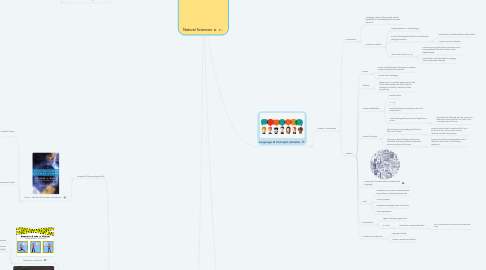
1. Scope & Application (Siyu)
1.1. Areas of natural sciences
1.1.1. life science
1.1.1.1. biology
1.1.1.1.1. examines phenomena related to living organisms
1.1.1.1.2. scale
1.1.1.1.3. fields
1.1.2. physical science
1.1.2.1. physics
1.1.2.1.1. study of fundamental constituents of the universe, forces and interactions and their results
1.1.2.1.2. "the fundamental science"
1.1.2.2. chemistry
1.1.2.2.1. constitutes the study at the atomic and molecular scale
1.1.2.2.2. composition, statistical properties, transformations, reactions
1.1.2.2.3. most processes can be studied in labs
1.1.2.2.4. rooted from alchemy
1.1.2.2.5. systemized by discovery of chemical elements & atomic theory
1.1.2.2.6. "the central science"
1.1.2.2.7. applications
1.1.2.3. astronomy
1.1.2.3.1. science of celestial objects and phenomena outside Earth
1.1.2.4. earth science
1.1.2.4.1. related to the planet earth
1.1.2.4.2. applications
1.1.2.5. material science
1.1.2.5.1. matter and its properties
1.1.2.5.2. discovery and design of new materials
1.2. nature's patterns
1.2.1. a pattern is
1.2.1.1. something regular, not completely random
1.2.1.2. not necessarily with identical elements
1.2.2. all kinds of scientists are interested in patterns
1.2.3. Turing structures
1.2.3.1. explains how chemicals interact
1.2.3.2. may apply to biological patterns as well
1.3. reductionism
1.3.1. reduce complex systems into fewer and more basic terms
1.3.1.1. Pro: help scientists understand basic parts
1.3.1.2. Con: not able to represent the whole
2. Historical Development (Kayris)
2.1. Science over time
2.1.1. Proposal of the paradigm/shifts
2.1.1.1. Kuhn's "Structure of Scientific Revolutions"
2.1.1.1.1. Refuted prior beliefs that scientific history is linear
2.1.1.1.2. Proposed cyclical advancement model
2.1.2. Development of paradigms
2.1.2.1. Physics
2.1.2.1.1. Newtonian mechanics
2.1.2.1.2. Gave way to Einsteinian relativity theory
2.1.2.1.3. Evolution of atomic model
2.1.2.2. Chemistry
2.1.2.2.1. Schroedinger Equation
2.1.2.2.2. --> Omega intracule
2.1.2.2.3. Old Density Functional Theory
2.1.2.3. Biology
2.1.2.3.1. Evolution
2.1.2.3.2. Medicine
2.1.2.4. The scientific method (of challenging held theories through experimentation)
2.1.2.5. Can be altered due to outside influences
2.1.2.5.1. Faith
2.1.2.5.2. Intuition
2.1.2.5.3. Bias (usually confirmation)
3. Methodology (Josephine)
3.1. Knowledge Production in NS
3.1.1. Based on rationalism = using reason as primary WOK
3.1.1.1. Inductive Method
3.1.1.1.1. 1) Observation is made
3.1.1.1.2. 2) Collection of data
3.1.1.1.3. 3) Interpretation of data
3.1.1.1.4. 4) Hypothesis / Conjecture is made
3.1.1.2. Hypothetico-deductive Method
3.1.1.2.1. 1) Starts with hypothesis
3.1.1.2.2. 2) Experiments
3.1.1.2.3. 3) Outcome / Conclusion drawn from results
3.1.1.3. Accuracy VS Precision
3.1.1.3.1. accuracy = how close measured values are to "true" value
3.1.1.3.2. precision = how consistent are the results you obtain from the same method
3.1.1.3.3. development of new technology
4. Language & Concepts (Amelie)
4.1. Science v Humanities
4.1.1. Humanities
4.1.1.1. Language need not be precise, what's important is understanding the key idea behind it
4.1.1.2. Focuses on trends
4.1.1.2.1. Largely based on Anthropology
4.1.1.2.2. It should be expected that human behavior changes overtime
4.1.1.2.3. VERY hard to have x--> y
4.1.2. Science
4.1.2.1. Precise
4.1.2.1.1. Exact understanding of the idea is needed. Empirical evidence is needed.
4.1.2.1.2. cannot have ambiguity
4.1.2.2. Verbose
4.1.2.2.1. Steps (eg in a scientific experiment) need to be clear, people should be able to recreate it perfectly. Need to include everything.
4.1.2.3. Causal relationships
4.1.2.3.1. Delivers facts
4.1.2.3.2. x --> y
4.1.2.3.3. Predicts outcomes using formulae and observations
4.1.2.3.4. Alternative hypothesis and Null hypothesis in use
4.1.2.4. Abstract theories
4.1.2.4.1. Part of science is accepting that there is still a lot to know
4.1.2.4.2. This may mean that they can become outdated, but that should be expected. Science evolves all the time.
4.1.2.5. Heavy use of mathematical concepts and language
4.1.2.6. Units
4.1.2.6.1. Needed in science for measurements, humanities no exact measurements
4.1.2.6.2. Use of symbols
4.1.2.6.3. Diagrams and graphs also need units
4.1.2.6.4. Latin expressions
4.1.2.7. Conventions
4.1.2.7.1. Type of arbitrary agreement
4.1.2.7.2. SI Units
4.1.2.8. Models and Metaphors
4.1.2.8.1. represent reality
4.1.2.8.2. Solves a particular problem
5. Personal Knowledge (Everyone <3)
5.1. SCHOOL
5.1.1. Mathematics as foundation
5.1.1.1. logical reasoning in seeking patterns
5.1.1.1.1. create models to predict nature
5.1.1.2. mathematical proof in determining truth
5.1.1.2.1. e.g. induction & deduction, applied in natural sciences
5.1.1.3. especially closely related to physics
5.1.2. Economics v Science
5.1.2.1. Economics is a humanities, and a lot concepts are under assumptions (eg the consumer is rational)
5.1.2.2. Economics still includes the use of math, although it is used to predict behaviors and economical outcomes
5.1.2.3. At our level of learning, entirely precise language of science is not used
5.1.2.3.1. Actual explanations probably too complicated
5.1.2.3.2. Most likely learn an oversimplified version
5.1.3. Psychology (human)
5.1.3.1. As an application of biochemical science
5.1.3.1.1. Uses concrete knowledge of human biological functions (as results of chemical processes)
5.1.3.1.2. Synthesised with abstract assumptions
5.1.3.1.3. Limited by current ability to study the brain
5.1.3.2. As a behavioural science
5.1.3.2.1. Can be used in predicting peoples' reactions in various situations
5.1.3.2.2. used to explain human behaviour
5.1.3.2.3. Useful in constructing understandings of past
5.1.3.2.4. Methodology
5.1.3.3. Limitations in terms of confirmation of theories
5.1.3.3.1. Until more advanced methods of study are devised, much of psychology will remain categorised as "highly plausible" rather than "fully accepted"
5.1.3.3.2. Restricts recognition of psychology as a "true" science
5.1.3.4. Connections to neuroscience
5.1.3.4.1. New field of medicine
5.2. PERSONAL LIFE
5.2.1. We used reason as a WOK to deduce people's feelings, their motives etc.
5.2.1.1. Inductive Method Example
5.2.1.1.1. 1) When person X is around, person Y appears happier
5.2.1.1.2. 2) Count number of times person X appears; number of times person Y smiles / laugh / talks more when X appears
5.2.1.1.3. 3) Person Y seems to smile more when person X is around
5.2.1.1.4. 4) Person Y likes person X
